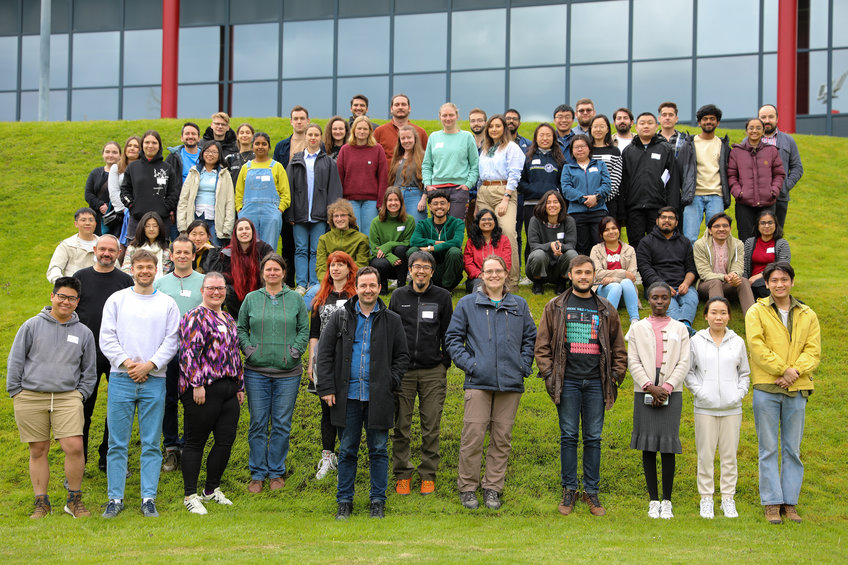
Publications of W. J. J. Soppe
All genres
Journal Article (29)
2020
Journal Article
Arabidopsis thaliana SEED DORMANCY 4-LIKE regulates dormancy and germination by mediating the gibberellin pathway. Journal of Experimental Botany 71 (3), pp. 919 - 933 (2020)
Journal Article
REVERSAL OF RDO5 1, a Homolog of Rice Seed Dormancy4, Interacts with bHLH57 and Controls ABA Biosynthesis and Seed Dormancy in Arabidopsis. Plant Cell 32 (6), pp. 1933 - 1948 (2020)
2019
Journal Article
Seed traits are pleiotropically regulated by the flowering time gene PERPETUAL FLOWERING 1 (PEP1) in the perennial Arabis alpina. Molecular Ecology 28 (5), pp. 1183 - 1201 (2019)
Journal Article
Dynamic hydrolase labelling as a marker for seed quality in Arabidopsis seeds. Biochemical Journal 476, pp. 843 - 857 (2019)
2017
Journal Article
Redox Changes During the Cell Cycle in the Embryonic Root Meristem of Arabidopsis thaliana. ANTIOXIDANTS & REDOX SIGNALING 27 (18), pp. 1505 - 1519 (2017)
Journal Article
Delay of germination requires PP2C phosphatases of the ABA signalling pathway to control seed dormancy. Nature Communications 8, 72 (2017)
Journal Article
The release of dormancy, a wake-up call for seeds to germinate. Current Opinion in Plant Biology, Special Issue: Growth and development SI: 35, pp. 8 - 14 (2017)
2016
Journal Article
ranscriptome and degradome sequencing reveals dormancy mechanisms of Cunninghamia lanceolate seeds. Plant Physiology 172, pp. 2347 - 2362 (2016)
Journal Article
Alternative splicing enhances transcriptome complexity in desiccating seeds. Journal of Integrative Plant Biology 58 (12), pp. 947 - 958 (2016)
Journal Article
Arabidopsis seed germination speed is controlled by SNL histone deacetylase-binding factor-mediated regulation of AUX1. Nature Communications 7, 13412 (2016)
Journal Article
Sequence Polymorphisms at the REDUCED DORMANCY5 Pseudophosphatase Underlie Natural Variation in Arabidopsis Dormancy. Plant Physiology 171 (4), pp. 2659 - 2670 (2016)
2015
Journal Article
Seed dormancy in Arabidopsis requires self-binding ability of DOG1 protein and the presence of multiple isoforms generated by alternative splicing. PLoS Genetics, e1005737 (2015)
Journal Article
Secondary dormancy in Brassica napus is correlated with enhanced BnaDOG1 transcript levels. Seed Science Research 25 (SI 2), pp. 221 - 229 (2015)
2014
Journal Article
HISTONE DEACETYLASE 9 represses seedling traits in Arabidopsis thaliana dry seeds. The Plant Journal 80 (3), pp. 475 - 488 (2014)
Journal Article
REDUCED DORMANCY5 Encodes a Protein Phosphatase 2C That Is Required for Seed Dormancy in Arabidopsis. The Plant Cell 26 (11), pp. 4362 - 4375 (2014)
2013
Journal Article
Arabidopsis Paired Amphipathic Helix Proteins SNL1 and SNL2 Redundantly Regulate Primary Seed Dormancy via Abscisic Acid-Ethylene Antagonism Mediated by Histone Deacetylation. The Plant Cell 25 (1), pp. 149 - 166 (2013)
2012
Journal Article
Molecular mechanisms of seed dormancy. Plant, Cell and Environment 35 (10), pp. 1769 - 1786 (2012)
Journal Article
The Time Required for Dormancy Release in Arabidopsis Is Determined by DELAY OF GERMINATION1 Protein Levels in Freshly Harvested Seeds. The Plant Cell 24 (7), pp. 2826 - 2838 (2012)
Journal Article
A novel role for histone methyltransferase KYP/SUVH4 in the control of Arabidopsis primary seed dormancy. New Phytologist 193 (3), pp. 605 - 616 (2012)
2011
Journal Article
DOG1 expression is predicted by the seed-maturation environment and contributes to geographical variation in germination in Arabidopsis thaliana. Molecular Ecology 20 (16), pp. 3336 - 3349 (2011)
Journal Article
Identification of the Arabidopsis REDUCED DORMANCY 2 Gene Uncovers a Role for the Polymerase Associated Factor 1 Complex in Seed Dormancy. PLoS One 6 (7), 10.1371/journal.pone.0022241, p. e22241 (2011)
Journal Article
Seed maturation in Arabidopsis thaliana is characterized by nuclear size reduction and increased chromatin condensation. PROCEEDINGS OF THE NATIONAL ACADEMY OF SCIENCES OF THE UNITED STATES OF AMERICA 108 (50), pp. 20219 - 20224 (2011)
2010
Journal Article
The Conserved Splicing Factor SUA Controls Alternative Splicing of the Developmental Regulator ABI3 in Arabidopsis. Plant Cell 22 (6), pp. 1936 - 1946 (2010)
2009
Journal Article
Natural modifiers of seed longevity in the Arabidopsis mutants abscisic acid insensitive3-5 (abi3-5) and leafy cotyledon1-3 (lec1-3). New Phytologist 184 (4), 10.1111/j.1469-8137.2009.03023.x, pp. 898 - 908 (2009)
2008
Journal Article
Molecular networks regulating Arabidopsis seed maturation, after-ripening, dormancy and germination. New Phytologist 179 (1), doi:10.1111/j.1469-8137.2008.02437.x, pp. 33 - 54 (2008)
Journal Article
Arabidopsis COP1 shapes the temporal pattern of CO accumulation conferring a photoperiodic flowering response. EMBO Journal 27, pp. 1277 - 1288 (2008)
2007
Journal Article
Control of FWA gene silencing in Arabidopsis thaliana by SINE-related direct repeats. Plant Journal 49 (1), doi:10.1111/j.1365-313X.2006.02936., pp. 38 - 45 (2007)
Journal Article
The Absence of Histone H2B Monoubiquitination in the Arabidopsis hub1 (rdo4) Mutant Reveals a Role for Chromatin Remodeling in Seed Dormancy. Plant Cell 19, 10.1105/tpc.106.049221, pp. 433 - 444 (2007)
2004
Journal Article
Photoreceptor regulation of CONSTANS protein in photoperiodic flowering. Science 303 (5660), pp. 1003 - 1006 (2004)
Book Chapter (3)
2016
Book Chapter
Dormancy in plants. In: Encyclopedia of Life Science, pp. 1 - 7. Wiley, Hoboken (2016)
2013
Book Chapter
Epigenetic Signalling During the Life of Seeds. In: Epigenetic Memory and Control in Plants (Signaling and Communication in Plants, Volume 18), pp. 127 - 153 (Eds. Grafi, G.; Ohad, N.). Springer, Heidelberg (2013)
2007
Book Chapter
Genetics aspects of seed dormancy. In: Seed Development, Dormancy and Germination, pp. 113 - 132 (Eds. Bradford; J., K.; H., N.). Blackwell Publishing, Oxford (2007)
Other (1)
2011
Other
Der Schlaf und das Erwachen von Pflanzensamen, Max-Planck-Society Yearbook 2011, (2011)